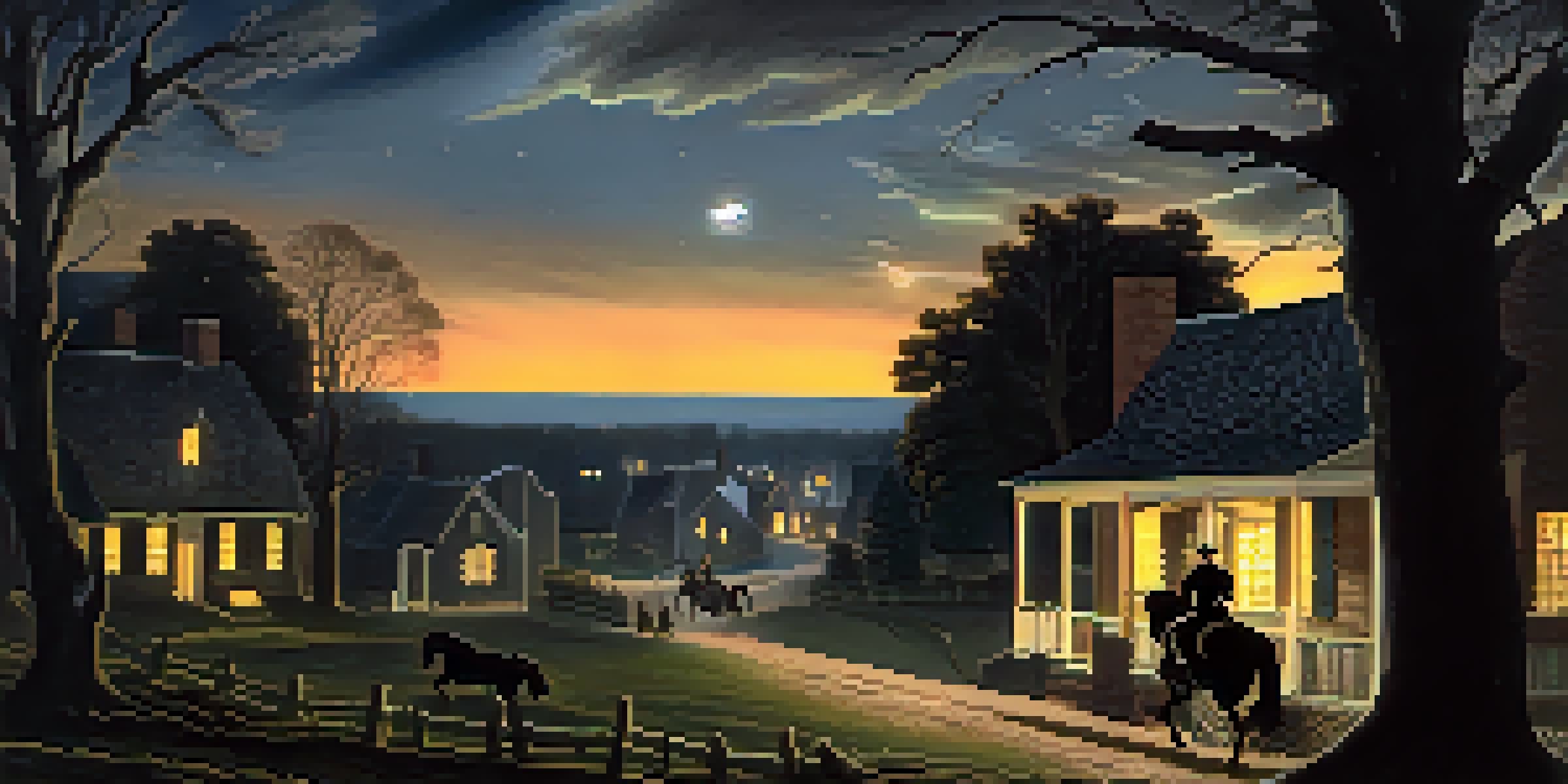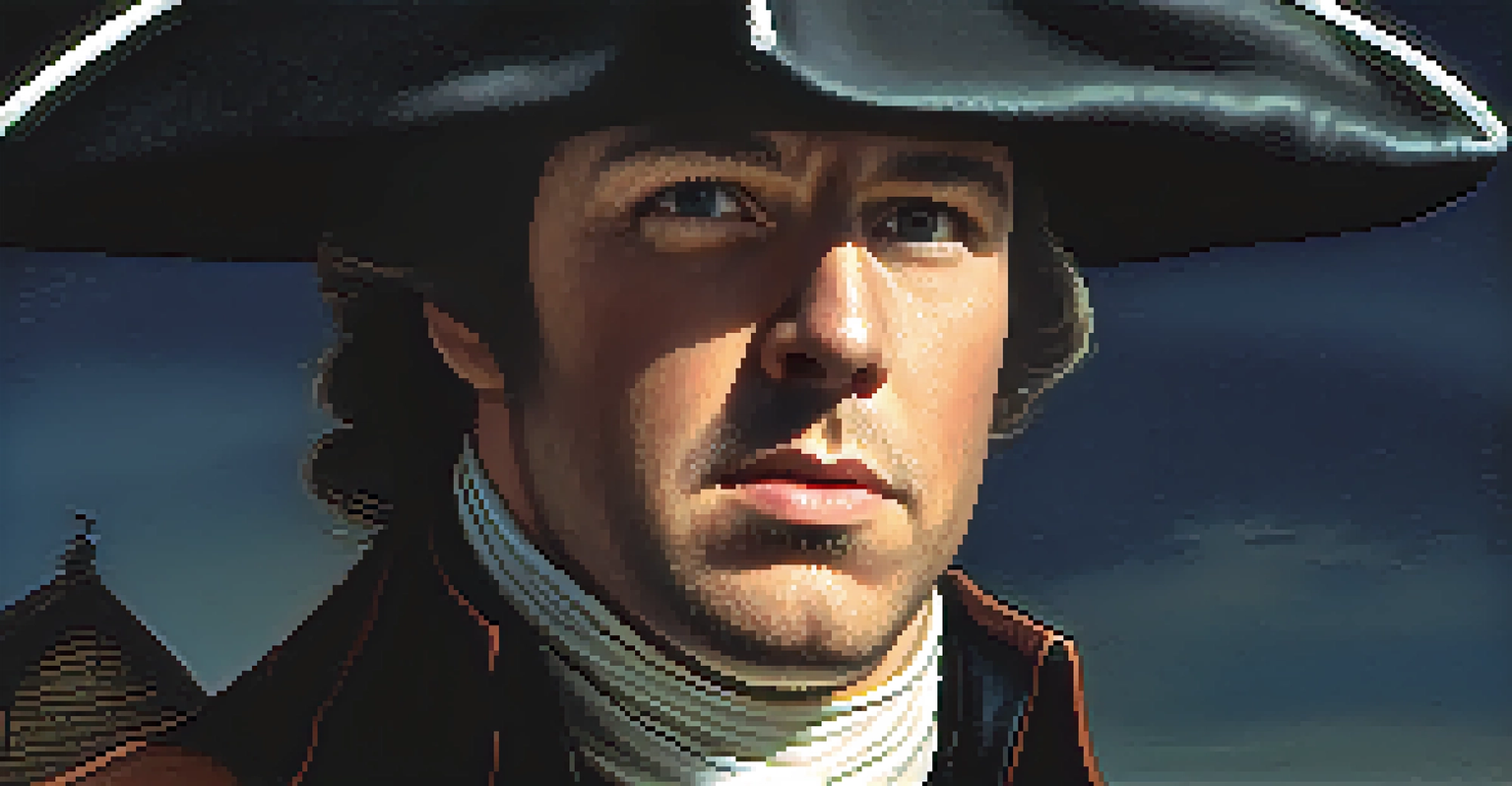Paul Revere’s Midnight Ride: A Revolutionary Tale Retold

The Historical Context of Revere’s Ride
In the early 1770s, tensions between the American colonies and British authorities were escalating. The oppressive measures imposed by the British government fueled a growing desire for independence among colonists. Paul Revere, a silversmith and staunch patriot, emerged as a key figure during this turbulent period. His midnight ride on April 18, 1775, was not just a spontaneous act but a carefully planned mission to warn fellow patriots of impending danger.
The American Revolution was a beginning, not a consummation.
At the heart of this story lies the fear of British troops advancing on American soil. The colonists were aware that the British aimed to seize arms stored in Concord, Massachusetts. Revere’s role was crucial in rallying the militias, as he understood that immediate action was necessary to counter the British forces. The ride symbolized not only a warning but also a call to unity among the colonies, igniting the spark of revolution.
Understanding the historical backdrop of Revere's ride helps us appreciate its significance. It was a culmination of years of mounting frustration and desire for autonomy. The events of that night laid the groundwork for a revolution that would change the course of history, making Revere a pivotal character in the American narrative.
The Journey Begins: Revere’s Preparation
Before the ride, Revere meticulously planned his route and the messaging he needed to convey. He coordinated with fellow patriots like Dr. Joseph Warren, who informed him of the British troop movements. This preparation was essential, as every minute counted. Revere knew that his ride would be the last chance to alert the colonial militias and prepare them for battle.

On the evening of April 18, the sky was dark, and the air was thick with tension. Revere set out on horseback, armed with a message that could change the fate of the colonies. He famously used the signal system of lanterns— 'one if by land, two if by sea'—to indicate the route the British would take. This clever signaling helped others join in the effort to spread the alarm.
Revere's Ride Ignited Revolution
Paul Revere's midnight ride galvanized colonial militias, leading to the first battles of the Revolutionary War.
Revere’s preparation highlights the importance of communication and strategy in times of crisis. His foresight and willingness to act under pressure demonstrate the qualities of leadership that inspired many to take up arms. It was not just about riding; it was about rallying a community to stand together against tyranny.
The Midnight Ride: A Night of Heroes
As Revere galloped through the night, he encountered numerous challenges. The darkness of the night was a daunting obstacle, but his determination pushed him forward. Along the way, he stopped at various homes and farms, warning families of the approaching British troops. Each encounter added to the urgency of his mission, igniting the spirit of resistance among the colonists.
The price of freedom is eternal vigilance.
Interestingly, Revere was not alone on this ride. He was joined by William Dawes, another patriot who had also set out to deliver the warning. The two men took different routes to cover more ground, showcasing the collaborative effort of the patriots. Their combined efforts amplified the message, ensuring that more people were alerted to the imminent threat.
This night was not just about Revere; it was a collective effort of individuals willing to risk their safety for the greater good. The bravery displayed by Revere and his contemporaries exemplified the resolve of those who sought freedom. Their actions that night became a legendary part of American history, embodying the spirit of rebellion.
The Impact of Revere’s Ride on the Revolution
Revere's midnight ride had an immediate and profound impact on the American Revolution. The warnings he delivered galvanized the militias, leading to the battles of Lexington and Concord the following day. These engagements marked the official start of the Revolutionary War, as the colonists stood up to British forces for the first time. Revere’s efforts helped transform a simmering conflict into an all-out fight for independence.
Moreover, the ride became a symbol of patriotism and courage. It inspired countless others to join the fight against British rule. The story was retold in poems and songs, most famously by Henry Wadsworth Longfellow, who immortalized Revere’s journey in American folklore. This narrative helped solidify Revere’s status as a national hero, representing the spirit of the revolution.
Collective Effort in Patriotism
Revere's ride was part of a broader network of patriots, emphasizing the importance of teamwork in the fight for independence.
The legacy of Revere's ride goes beyond its immediate consequences. It illustrates how one individual's actions can resonate through history, inspiring future generations. The ride exemplified the theme of resistance against oppression, a cornerstone of American identity.
The Myths and Misconceptions of Revere’s Ride
While Paul Revere's ride is celebrated, it's important to address the myths that have emerged over the years. A common misconception is that Revere rode alone, but he was part of a broader network of patriots. Other riders, like Dawes and Samuel Prescott, played equally vital roles in spreading the warning. This communal effort emphasizes the collaborative nature of the revolutionary movement.
Another popular myth is that Revere’s ride was a heroic solo mission. In reality, the ride was just one part of a larger campaign to inform the colonies. The focus on Revere in popular culture often overshadows the contributions of others. Recognizing these contributions provides a fuller picture of the fight for independence and highlights the teamwork that characterized the revolution.
By debunking these myths, we can appreciate the collective effort behind the revolution. It reminds us that history is often more nuanced than the stories we tell. Understanding the true nature of events like Revere’s ride allows us to honor not just one individual, but the many who fought for freedom.
Revere’s Legacy in American Culture
Paul Revere’s midnight ride has left an indelible mark on American culture. His story is woven into the fabric of American identity, symbolizing bravery, vigilance, and the fight for freedom. Statues, monuments, and even schools bear his name, serving as reminders of his contributions to the nation. His legacy is celebrated every year, especially during events honoring the revolution.
In literature and art, Revere is often depicted as a quintessential American hero. His ride has been romanticized, becoming a quintessential example of the American spirit. The phrase 'the British are coming' has become synonymous with his journey, even though it may not have been uttered as famously as we believe. This cultural representation reinforces the idea of standing up against tyranny.
Legacy of Vigilance and Action
Revere's story inspires ongoing civic duty, reminding us to stand up for our beliefs and engage in our communities.
Revere’s legacy also serves as a reminder of the importance of civic duty. His actions inspire current and future generations to remain vigilant in protecting their rights. The story of Paul Revere is not just about the past; it encourages us to engage with our communities and uphold the ideals of freedom and justice.
Lessons from Paul Revere’s Midnight Ride
Reflecting on Paul Revere’s midnight ride, we can draw valuable lessons about leadership and community action. His preparation and determination highlight the significance of having a plan when faced with challenges. Revere's ability to mobilize others reminds us that collective efforts can lead to significant change, especially in times of crisis.
Another lesson is the importance of communication. Revere’s effective use of signals and word-of-mouth illustrates how vital it is to share information swiftly and accurately. In today’s fast-paced world, the ability to communicate clearly can make all the difference, whether in emergencies or everyday life. This principle is timeless, transcending historical boundaries.

Ultimately, the story of Paul Revere encourages us to stand up for our beliefs and take action when necessary. It serves as a powerful reminder that history is shaped by the choices of individuals and their willingness to act. As we remember Revere's ride, let's honor his legacy by remaining engaged citizens who advocate for justice and freedom.